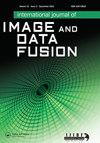基于Kullback-Leibler散度的高分辨率卫星图像半自动道路提取方法
IF 1.8
Q3 REMOTE SENSING
International Journal of Image and Data Fusion
Pub Date : 2022-09-13
DOI:10.1080/19479832.2022.2121767
引用次数: 0
摘要
为了加快道路地图的获取和更新,迫切需要道路的半自动提取。然而,在甚高空间分辨率(VHSR)遥感卫星图像上,路面经常受到干扰,这给基于最小二乘模板匹配的道路跟踪器带来了困扰。提出了一种基于VHSR卫星图像的半自动道路跟踪框架。首先,操作员输入三个种子点。其次,利用Kullback-Leibler散度作为相似度度量,通过模板匹配自动跟踪道路;同时,在跟踪过程中保留了一名人工操作员来监督提取的结果,以响应程序的提示。一旦发生故障或错误,人工操作员将纠正结果并重新启动自动跟踪。重复上述过程,直到跟踪整条道路。利用四幅不同复杂度的卫星图像进行实验。结果表明,本文提出的道路跟踪器能够自动、准确、快速地从VHSR卫星图像中提取长、高等级道路。本文章由计算机程序翻译,如有差异,请以英文原文为准。
Semi-automatic road extraction from high resolution satellite images by template matching using Kullback–Leibler divergence as a similarity measure
ABSTRACT Semi-automatic extraction of roads is greatly needed to accelerate the acquisition and updating of road maps. However, road surfaces are frequently disturbed on very high spatial resolution (VHSR) remotely sensed satellite imagery, which bothers the road trackers using least-squares-based template matching. This paper presents a novel semi-automatic framework for road tracking from VHSR satellite imagery. First, a human operator inputs three seed points. Second, the computer automatically tracks the road by the template matching using Kullback–Leibler divergence as a similarity measure. At the same time, a human operator is retained in the tracking process to supervise the extracted results, to response to the program’s prompts. Once the failure or error happens, the human operator will correct the results and restart the automatic tracking. The above procedure is repeated until a whole road is tracked. Four satellite images with different complexities are used to perform experiments. The results show that our proposed road trackers is capable of automatically, accurately and fast extracting the long and high-level roads from the VHSR satellite images.
求助全文
通过发布文献求助,成功后即可免费获取论文全文。
去求助
来源期刊

International Journal of Image and Data Fusion
REMOTE SENSING-
CiteScore
5.00
自引率
0.00%
发文量
10
期刊介绍:
International Journal of Image and Data Fusion provides a single source of information for all aspects of image and data fusion methodologies, developments, techniques and applications. Image and data fusion techniques are important for combining the many sources of satellite, airborne and ground based imaging systems, and integrating these with other related data sets for enhanced information extraction and decision making. Image and data fusion aims at the integration of multi-sensor, multi-temporal, multi-resolution and multi-platform image data, together with geospatial data, GIS, in-situ, and other statistical data sets for improved information extraction, as well as to increase the reliability of the information. This leads to more accurate information that provides for robust operational performance, i.e. increased confidence, reduced ambiguity and improved classification enabling evidence based management. The journal welcomes original research papers, review papers, shorter letters, technical articles, book reviews and conference reports in all areas of image and data fusion including, but not limited to, the following aspects and topics: • Automatic registration/geometric aspects of fusing images with different spatial, spectral, temporal resolutions; phase information; or acquired in different modes • Pixel, feature and decision level fusion algorithms and methodologies • Data Assimilation: fusing data with models • Multi-source classification and information extraction • Integration of satellite, airborne and terrestrial sensor systems • Fusing temporal data sets for change detection studies (e.g. for Land Cover/Land Use Change studies) • Image and data mining from multi-platform, multi-source, multi-scale, multi-temporal data sets (e.g. geometric information, topological information, statistical information, etc.).
 求助内容:
求助内容: 应助结果提醒方式:
应助结果提醒方式:


